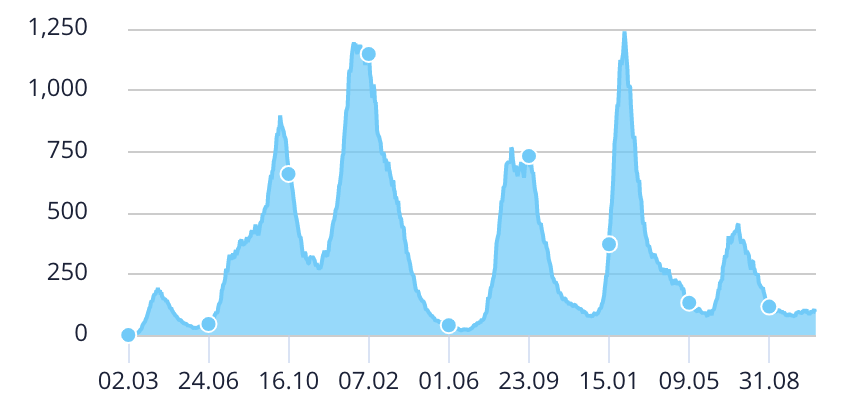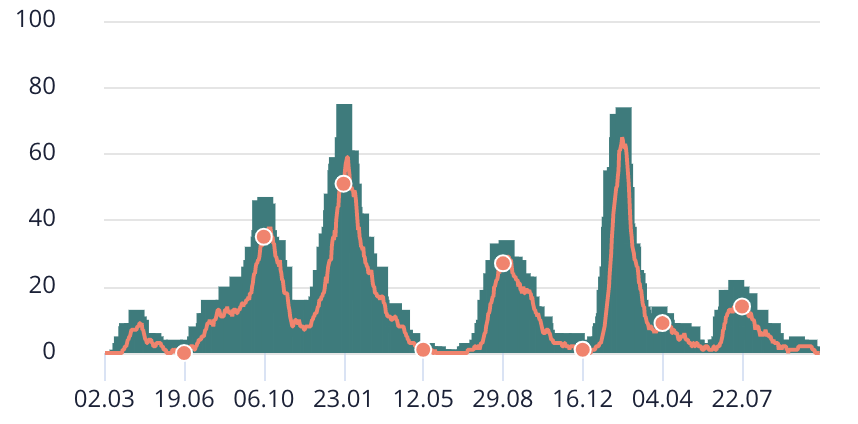Cases still low but new COVID strains spreading, with ominous echoes of past winters

With ominous echoes of past winters, as the mercury is dropping, new COVID variants are spreading.
It’s just under a year since a world that was finally shedding its masks was shaken by the emergence of the Omicron variant. Within a few weeks of its November 24, 2021, documentation at the World Health Organization, it was infecting larger numbers than any previous strain.
A year earlier, winter in much of the northern hemisphere was dominated by the massive spread of the Alpha variant, then widely known as the UK variant. In Israel, this meant the third nationwide lockdown.
Today, descendants of the original Omicron are spreading fast. In many Asian countries a lineage called XBB is making major inroads.
In Europe, North America, Africa and Israel the BQ.1 family is on the rise. It accounts for about a third of cases in America. In Israel, it accounts for 17 percent of reported cases, according to Prof. Nadav Davidovitch, a top epidemiologist and a government coronavirus adviser.
“We expect it to start spreading quickly, and this should raise our concerns and prompt us to vaccinate and take precautions,” he told The Times of Israel.
He said that experts are still waiting to understand vital facts about the BQ.1 variants, such as exactly how fast they spread, how well they dodge immunity and how severely they cause illness. But he said that weeks ago the government and top doctors were already discussing scenarios for possible winter variants.
“We held roundtables with all ministries and the Home Front Command,” said Davidovitch, a professor at Ben Gurion University and a leader in the Israel Association of Public Health Physicians. “We don’t know how case numbers will change, but we do know that every winter, upper respiratory illnesses can lead to a burden on the health system.
“One scenario we looked at involves lots of COVID, but in a variant like Omicron that often isn’t severe. Another scenario involves a new variant that is more severe than Omicron, like Delta was.”

A special polling station for Israelis with COVID for the election on November 1, 2022. (AP Photo/Mahmoud Illean)
Israelis are unlikely to see restrictions reimposed if there is widespread infection by Omicron or another variant with a similarly low ratio of hospitalizations and serious cases, said Davidovitch. “But with a variant that causes more severe outcomes, Israel might consider surveillance and some restrictions on large gatherings,” he added.
This would mean the public would, once again, feel the impact of coronavirus rules, though Davidovitch said even with a serious variant, it is hard to imagine turning back the clock to widespread quarantines of people who encounter a carrier or significant restrictions on public life.
This will be the third pandemic winter. For Israel, government graphs give a clear picture of the surges that have come with the onset of winter over the last two years. The numbers of people hospitalized in serious condition peaked in late January or early February.

A graph from the Israeli Ministry of Health, with serious COVID cases on. the vertical axis and the date on the horizontal axis It shows peaks in late January/early February during the last two winters. (Israel Ministry of Health)
The same is true for the number of daily deaths, which is represented in green, while a moving average is shown in orange.

A graph from the Israeli Ministry of Health, with daily deaths on the vertical axis and the date on the horizontal axis. It shows peaks in late January/early February during the last two winters. (Israel Ministry of Health)
Globally, cases are falling. The number of new weekly cases decreased by 17% during the week of October 24 t0 30, 2022, as compared to the previous week, the World Health Organization reported — adding the caveat that it suspects the drop is exaggerated due to a decline in testing. Deaths fell by 5%.
In Israel, new daily cases are at a level similar to where they were a month ago — just under 900 — following a dip in the interim which may be explained by decreased testing around the Sukkot holiday.
There isn’t yet peer-reviewed research on either of the big questions regarding these variants, but there are some early insights. The University of Basel computational biologist Cornelius Roemer tweeted that based on his analysis, the the BQ.1 sub-lineage BQ.1.1 spreads fast, and suggested “it is becoming quite clear that BQ.1.1 will drive a variant wave in Europe and North America before the end of November.”
The European Centre for Disease Prevention and Control wrote that BQ.1 appears to have strong ability to slip past the immune system and indicated that it expects sub-lineages to do the same. “The observed increase in the growth rate of BQ.1 is probably driven mainly by immune escape,” the organization stated. “This variant and its sub-lineages will probably contribute to a further increase in cases of COVID-19 in the European Union/European Economic Area in the coming weeks and months.”
Reassuringly, the World Health Organization reports regarding BQ.1 that “at this time there is no epidemiological data to suggest an increase in disease severity.”

Prof. Nadav Davidovitch (courtesy of Ben Gurion University)
Davidovitch stressed that even if more is quickly learned about the BQ.1 family, there is still plenty of time for other variants to arise for the winter, meaning it would still be hard to make predictions. For now, people should focus on the variables they can control, he said.
The expert recommended that high-risk individuals should wear masks on public transportation and in public places, and he recommended that anyone who believes they have reason to test should do so.
He also reiterated that “vaccines, of course, are very important.”
“We are moving towards the normalization of COVID and maintaining some measures is part of this. But it’s broader than waiting to see what, if any, restrictions are needed,” he said.
“On a national level, while we don’t know how things will look, we need to invest in all the necessary systems, including the ability for testing labs to quickly increase capacity and preparation for home treatment of infected people.
“The idea of readiness actually goes beyond COVID. The health challenges we face are broader, and if there’s investment in the system, we’ll be ready for all the challenges including COVID,” he said.



